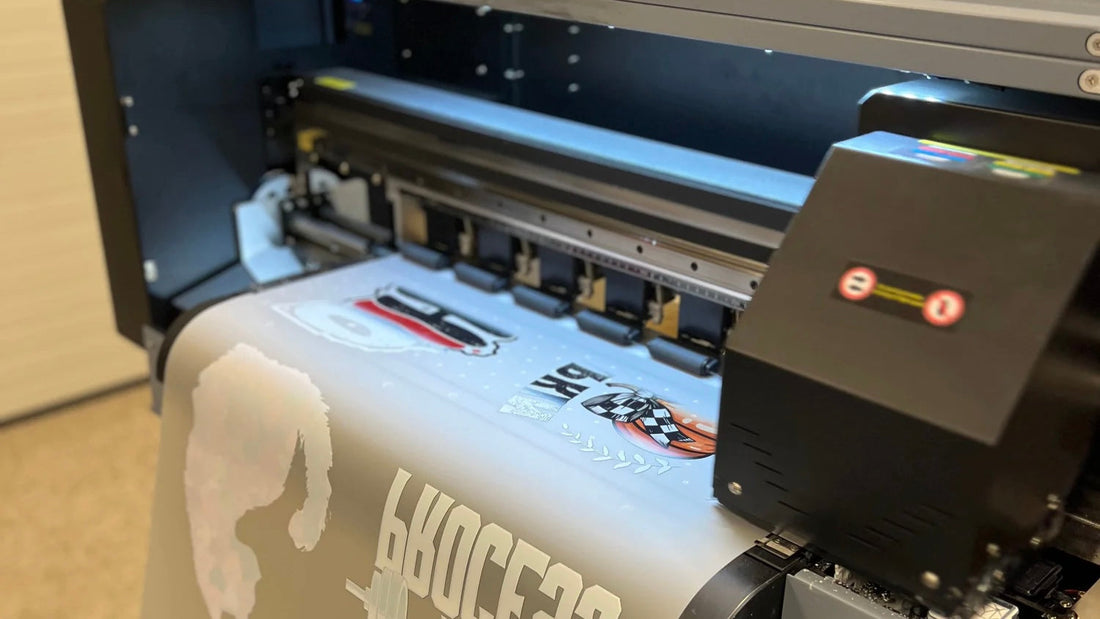
What is DTF Printing? Why It’s Ideal for Custom Apparel
If you’ve been exploring options for custom shirt printing, you’ve likely come across a buzzworthy term in the apparel world: DTF printing. Short for Direct-to-Film printing, this innovative technology is rapidly gaining popularity among designers, small businesses, and print shops because it produces high-quality, durable designs on a wide variety of fabrics, without many of the limitations seen in older methods.
What is DTF Printing?
DTF printing, or Direct-to-Film printing, is a relatively new technique for applying printed designs onto fabric. Unlike traditional heat transfers or screen printing, DTF doesn’t print directly onto the garment itself. Instead, the design is printed onto a special film, coated with a powdered adhesive, and then heat-pressed onto the fabric.
Think of it as a two-step process:
- Print or buy your design on a transfer sheet.
- Use heat and pressure to fuse it onto your garment.
The result is a vibrant, full-color print that feels soft to the touch, is highly durable, and works on a wide range of fabrics, not just cotton.
How DTF Printing Works – Step-by-Step
Let’s break down the DTF process so you can see why it’s quickly becoming a preferred method.
1. Design Creation
It all starts with your design—whether a logo, photo, or custom artwork. The design is prepared on a computer with graphic design software, ensuring it’s high resolution for crisp, detailed prints.
2. Printing on PET Film
Instead of printing on paper or fabric, DTF printers print the design onto a special PET (polyethylene terephthalate) film. The printer applies the design in two layers: first, a white ink layer as the base, then a colored ink layer on top to deliver full vibrancy.
3. Applying the Adhesive Powder
While the ink is still wet, a heat-activated adhesive powder is sprinkled onto the film. This powder is what will bond the design to your fabric.
4. Curing the Transfer
The film is then heated to partially melt the adhesive powder so it sticks to the ink, but not yet to the fabric.
5. Transferring to the Garment
The prepared film is carefully positioned on the garment—whether it’s a T-shirt, hoodie, hat, or tote bag—and heat-pressed with the correct temperature, pressure, and duration.
6. Peeling the Film
Finally, the film is peeled away (either hot or cold peel, depending on the film), leaving only the design permanently bonded to the fabric.
Why DTF Printing is Perfect for Custom Apparel
● Works on a Wide Variety of Fabrics
Unlike direct-to-garment (DTG) printing, which works best on 100% cotton, DTF printing can be applied to cotton, polyester, blends, fleece, nylon, and even leather. This versatility means you can create matching prints across gym gear, jackets, and more.
● Bright, Vibrant Colors
The white base layer combined with high-quality inks makes designs pop—even on dark fabrics—and keeps colors vivid wash after wash.
● Durable and Long-Lasting
Because the design is fused into the fibers using heat and adhesive, DTF prints resist cracking, fading, and peeling. This durability makes them perfect for everyday wear and repeated washing.
● Soft and Flexible Feel
Unlike screen printing, which can leave thick, plasticky designs, DTF prints feel soft and flexible, keeping garments comfortable.
● No Need for Pretreatment
DTG printing often requires a special pretreatment before printing. DTF skips this step, speeding up and simplifying production.
● Ideal for Both Small and Large Orders
With no need for costly screens or long setup times, DTF transfers are great for single items or bulk orders—perfect for small businesses, event merch, or personalized gifts.
Tips for Getting the Best Custom DTF Transfers
● Use high-resolution artwork to capture fine details.
● Choose the right film and adhesive powder for durability and feel.
● Follow proper heat press settings—temperature, pressure, and time are crucial.
● Store transfers in a cool, dry place until you’re ready to press.
● Wash garments inside out to help maintain print vibrancy longer.
Ready to create your custom transfer or apparel? Start here! Not sure where to start? Shop some of our premade designs. Any design can be made into a transfer!
Frequently Asked Questions About DTF Printing
1. What is DTF printing best suited for?
DTF printing is ideal for producing bold, durable designs on nearly any type of fabric. It works great for custom t-shirts, hoodies, tote bags, hats, and specialty pieces like jackets or aprons. Because it’s so versatile, it’s a favorite for sports teams, promotional merchandise, small business branding, and fashion lines.
2. How long will DTF prints last?
When applied and cared for correctly, DTF prints can look great for years without cracking, peeling, or fading. With proper care—washing garments inside-out in cold water and tumble-drying on low—most designs maintain their vibrancy for 50 or more washes.
3. Can DTF printing be used on dark fabrics?
Absolutely. One of the standout features of DTF is its ability to create bright, vivid designs on dark or even black materials. This is possible thanks to a white base layer that makes the colors pop.
4. How does DTF printing differ from DTG printing?
DTG vs. DTF printing. Both methods can produce detailed, full-color designs, but they work differently. DTF transfers the design from a film onto the fabric, allowing it to work on a wider range of materials, including polyester and blends. DTG prints directly onto the fabric and performs best on 100% cotton. DTF is typically more durable and doesn’t require pretreating the garment.
5. Can I purchase DTF transfers and apply them myself?
Yes! Many suppliers offer custom DTF transfers ready for you to press at home. You’ll receive printed transfer sheets, place them on your garment, and use a heat press to apply. It’s a simple way for crafters, small businesses, or individuals to create professional-quality apparel without special printing equipment.
More FAQs here!
